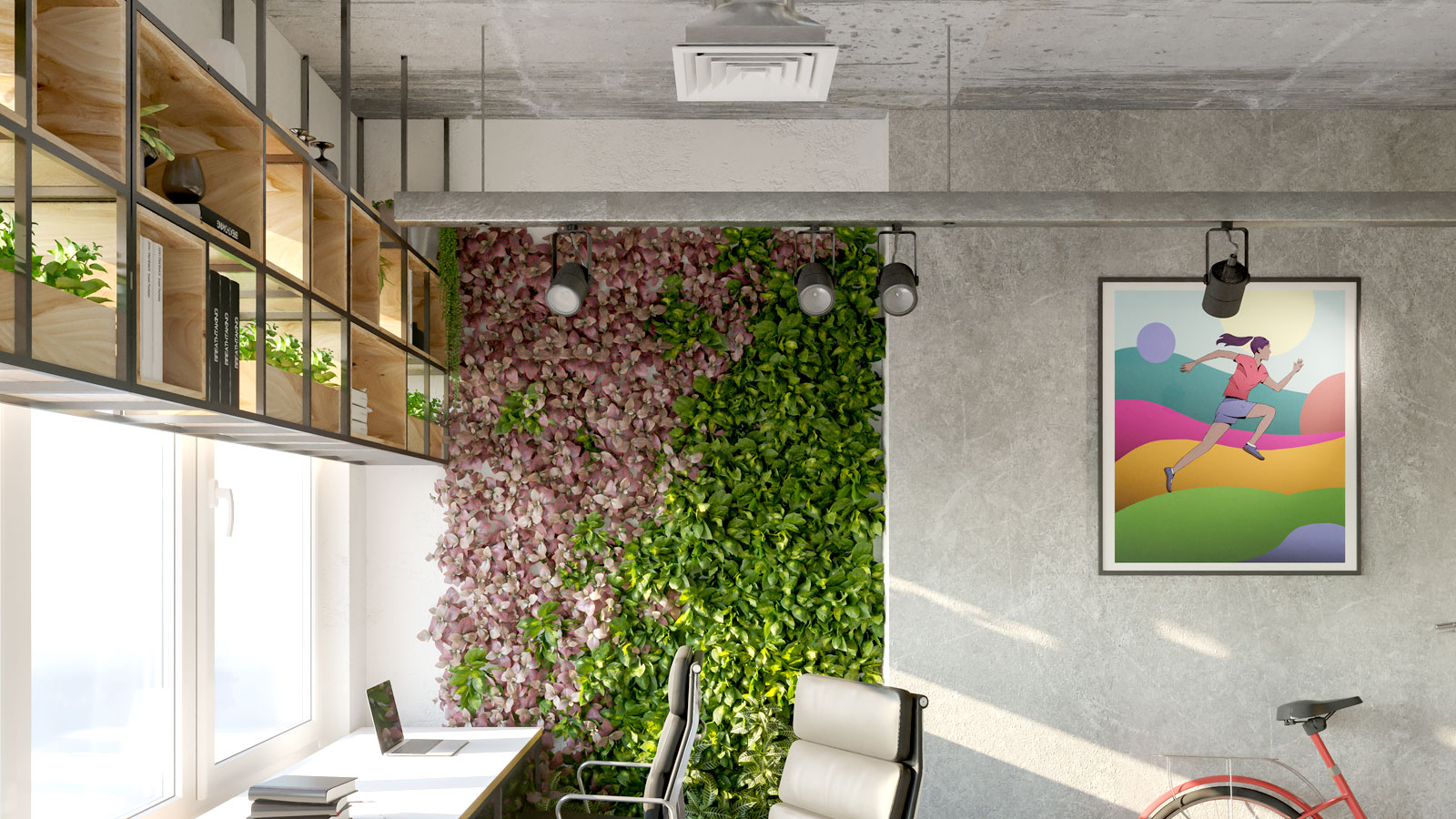These clever small kitchen storage ideas will change the way you think about your space
Try these small kitchen storage ideas to maximise your home's potential and make even the trickiest layouts feel more functional
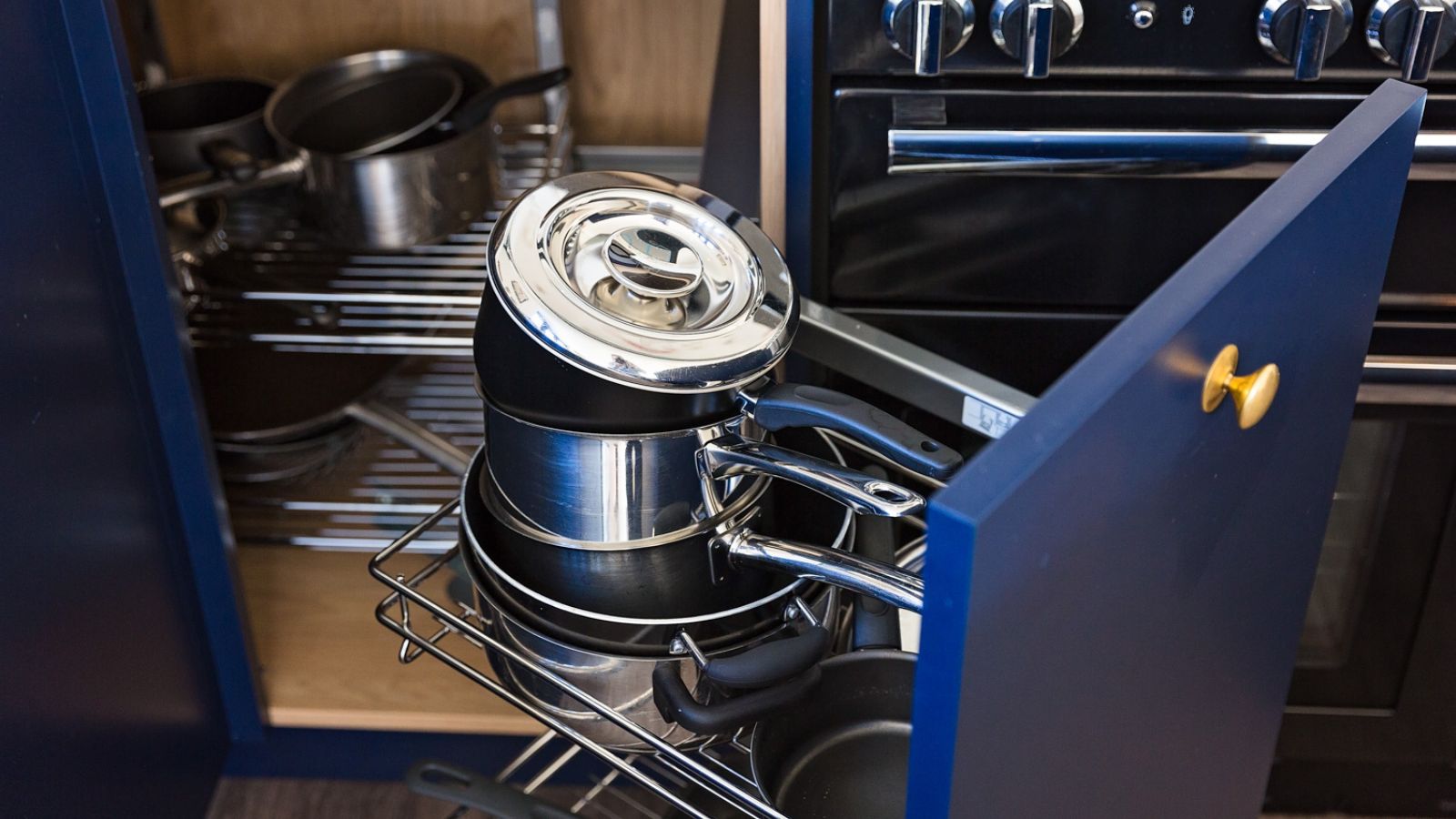
- 1. Embrace open shelving
- 2. Add slim, wall-mounted cabinets
- 3. Go down the bespoke route
- 4. Use your ceiling
- 5. Install a small kitchen pantry
- 6. Rework your kitchen drawers
- 7. Use rails and hooks
- 8. Consider a shelf niche
- 9. Add back door storage
- 10. Purchase a slimline trolley
- 11. Use pull-out cupboards
- 12. Use corners for storage
- FAQs
Having a compact galley kitchen or a tiny L-shaped layout doesn’t mean you have to compromise on storage or let clutter take over. From smart pull-out drawers to bespoke cabinetry, the right kitchen storage ideas can help you maximise every inch of your space, without making your home feel cramped.
We asked kitchen designers to share their top tips for making a small kitchen feel bigger and work harder. Whether you’re planning a new kitchen from scratch or looking for ways to improve your current kitchen design, their brilliant small kitchen storage ideas will help you create a space-savvy kitchen that’s as practical as it is beautiful.
Small kitchen storage ideas require creative thinking
"Small kitchens can be challenging but fun to design,” says Helen Parker, creative director of deVOL. "You have to make use of every little spot and be clever with depths and heights.”
Nicolle Whyte, design director at Olive and Barr, agrees, suggesting we celebrate the differences in these small rooms rather than try to hide them. “Compact kitchens come in an array of shapes and sizes and often homeowners are challenged with quirky shaped rooms and odd proportions," she explains. "Although such obstacles require extra thought and planning, they result in a unique kitchen design with an abundance of personality.
"When planning your kitchen, establish these elements and discuss with a designer how to make the most of them. It may be that alcoves could provide the perfect spot for the ultimate kitchen pantry, or an unused corner could offer the space for a dining nook, flanked with floor-to-ceiling cabinetry. In small kitchens, storage space is often limited, so seek out opportunities to incorporate extra shelving and cabinetry space wherever possible."
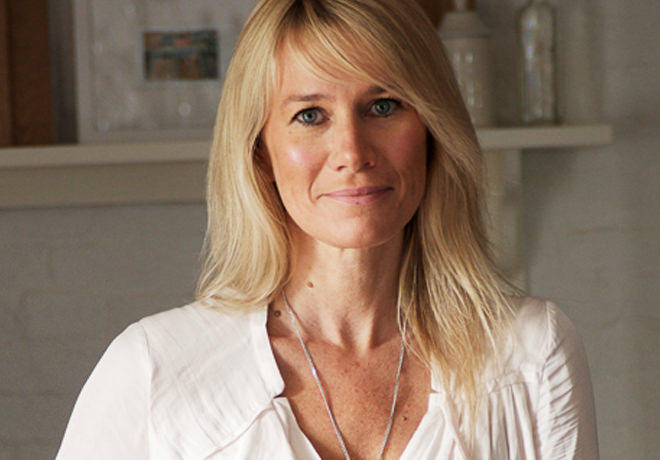
Helen Parker is the Creative Director at deVOL Kitchens, known for her impeccable eye for design, trend forecasting, and timeless kitchen aesthetics that blend craftsmanship, functionality, and character.

Nicolle is an experienced kitchen designer with a demonstrated history of working in the retail industry. She graduated from De Montfort University and now works for renowned kitchen design company, Olive & Barr.
1. Embrace the clean lines of open shelving
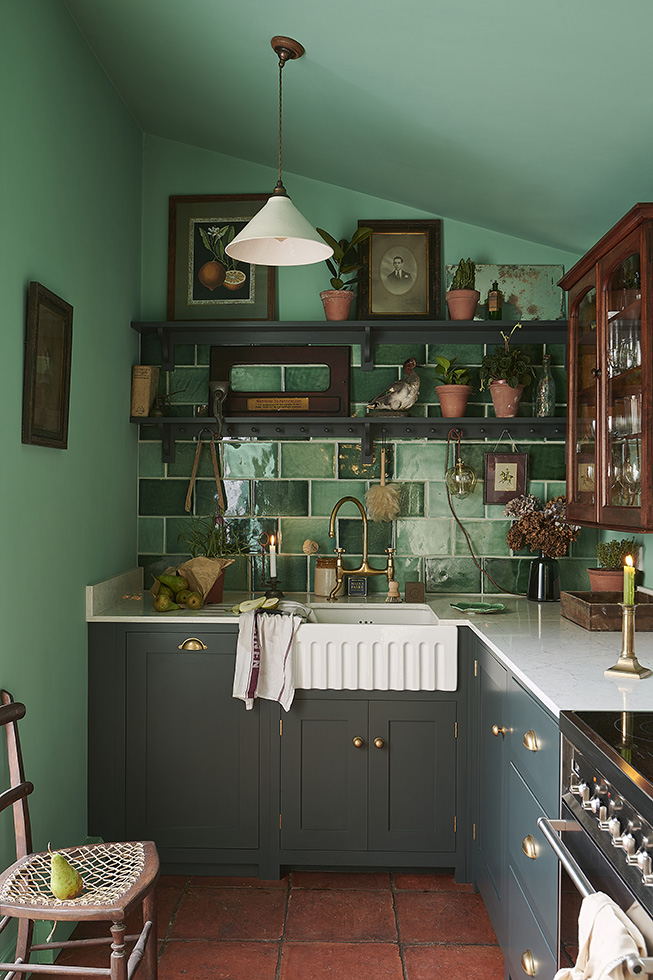
When space is in short supply, bulky overhead cabinets can make a small kitchen feel even more cramped. Open kitchen shelving offers a stylish and practical alternative, keeping your kitchen essentials within easy reach while creating a much more airy, open feel.
“Slim shelves can give you such good storage for glassware and tall shallow objects and also create a nice visual where wall space and spots for ornamentation are in short supply,” explains Helen Parker from deVOL.
“Open shelves are a really great use of space in a tight kitchen,” adds Jayne Everett, creative director at Naked Kitchens. “A shallow shelf can even be positioned above head height to make use of otherwise blank wall space.”
To make the most of your shelving, opt for narrow, well-spaced shelves that suit your storage needs without overwhelming the space. Use them to display everyday essentials like plates, mugs, and glassware, while keeping clutter at bay with decorative storage baskets or neatly arranged jars.
To prevent open shelves from looking messy, avoid overcrowding them with too many items. Stick to a curated mix of functional and decorative pieces, leaving enough breathing room between them. A simple rule of thumb is to group items in odd numbers and vary heights for a balanced display.
Extra Tip: You can also add hooks to the bottom of your shelves to hang extra utensils if you’re particularly short on space.

In 2000, following a successful career in finance, Jayne and her husband left London and settled in Norfolk to raise their young family. In 2005, her passion for design led to the couple founding Naked Kitchens. As creative director, Jayne now oversees the design of new showrooms and kitchen styles.
2. Think vertically with slim, wall-mounted cabinets
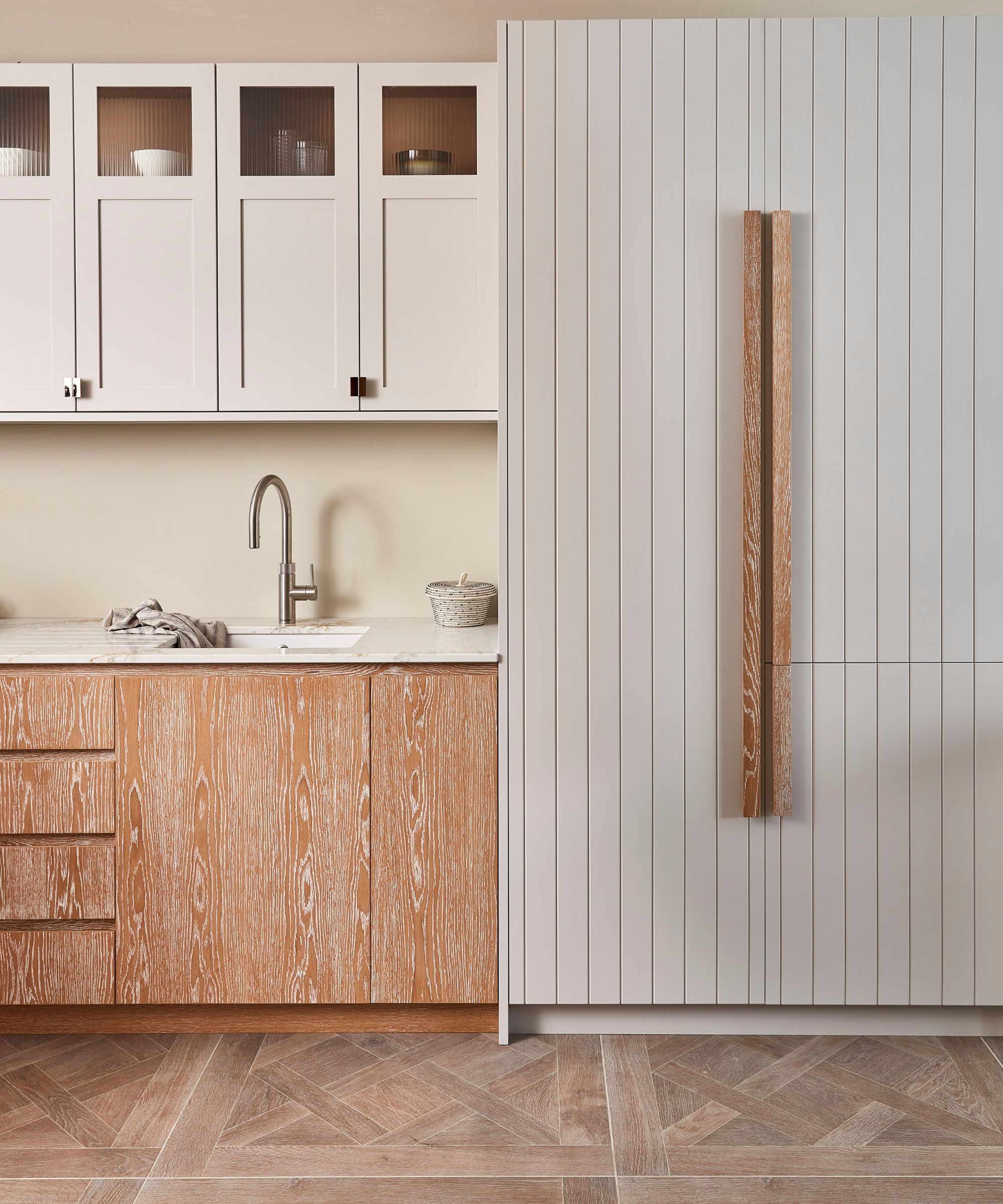
When floor space is tight, sometimes the only way is up. Slimline, wall-mounted kitchen cabinets and plate racks help keep clutter off your kitchen worktops while adding plenty of storage to smaller spaces.
If you want to keep wall cabinets feeling light while still concealing clutter, opt for shallow and slimline designs to avoid a bulky look and take them all the way to the ceiling to squeeze in extra space for those once-in-a-while kitchen gadgets.
"Remember, cabinetry doesn’t have to look identical," says Nicolle Whyte. "Glazed cabinets provide an opportunity to display your favourite glassware, while offering a break in a run of solid fronted doors.”
“Reeded glass is also a great way to disguise contents of wall cabinets,” adds Jayne Everett. This textural detail keeps storage practical without making the kitchen feel closed in.
3. Go down the bespoke route for cabinetry
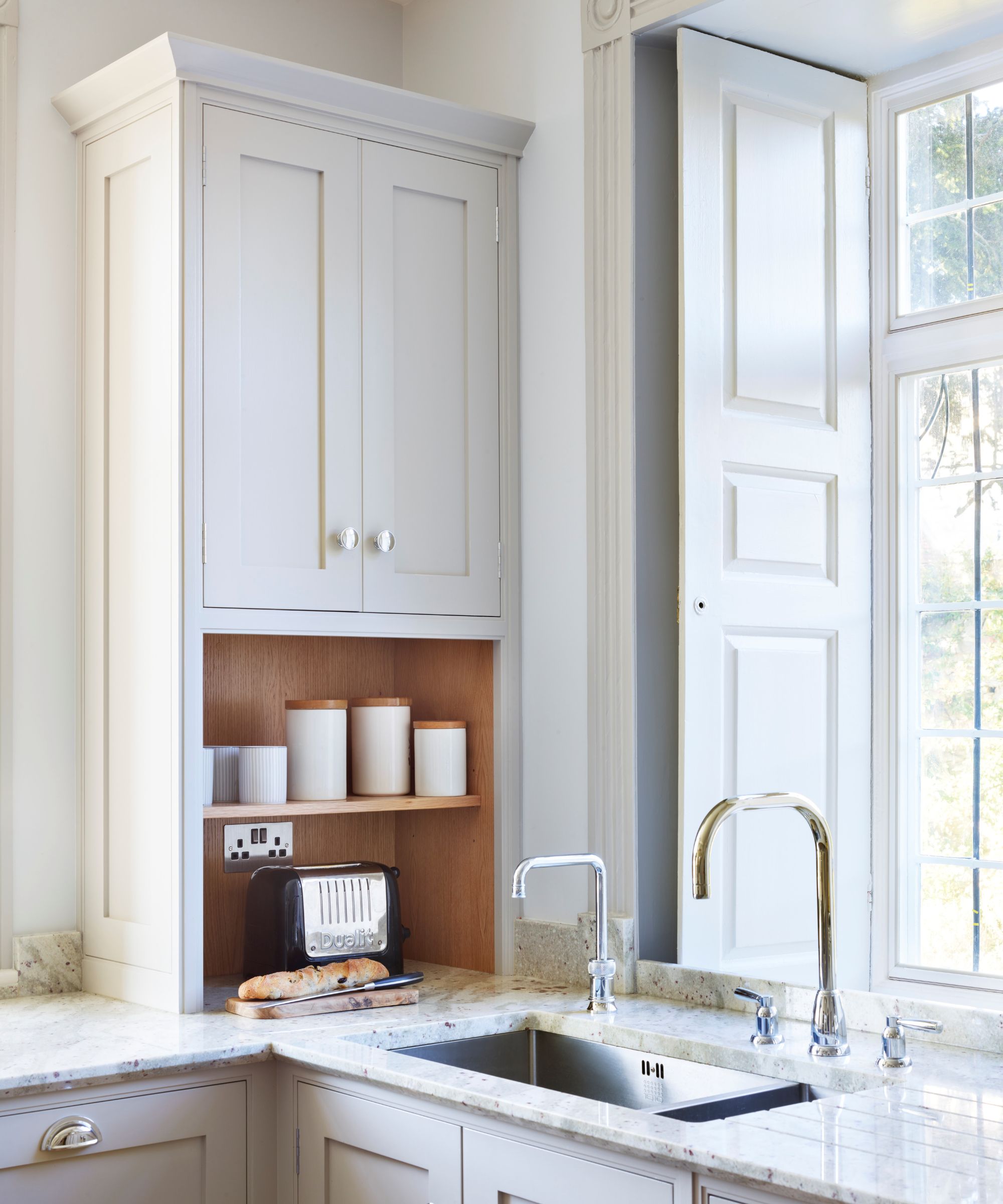
"Bespoke elements can play a key part in delivering a well-designed small kitchen, as standard cabinetry sizes don’t always suffice," explains Nicolle Whyte. "This creates an opportunity to truly invest in cabinetry that meets all your requirements while challenging you to consider what you do and don’t need from your new kitchen. Research and discuss alternative options with a designer – perhaps deep pan drawers would better suit your needs, or open shelving might be a more practical choice.”
Clever custom details can also help small kitchens feel more streamlined. “Pocket doors can be introduced to hide away workspaces so even a small space can remain tidy,” explains Jayne Everett. This is an ideal solution for keeping appliances, coffee stations, or prep areas out of sight when not in use.
4. Don't underestimate your ceiling's potential
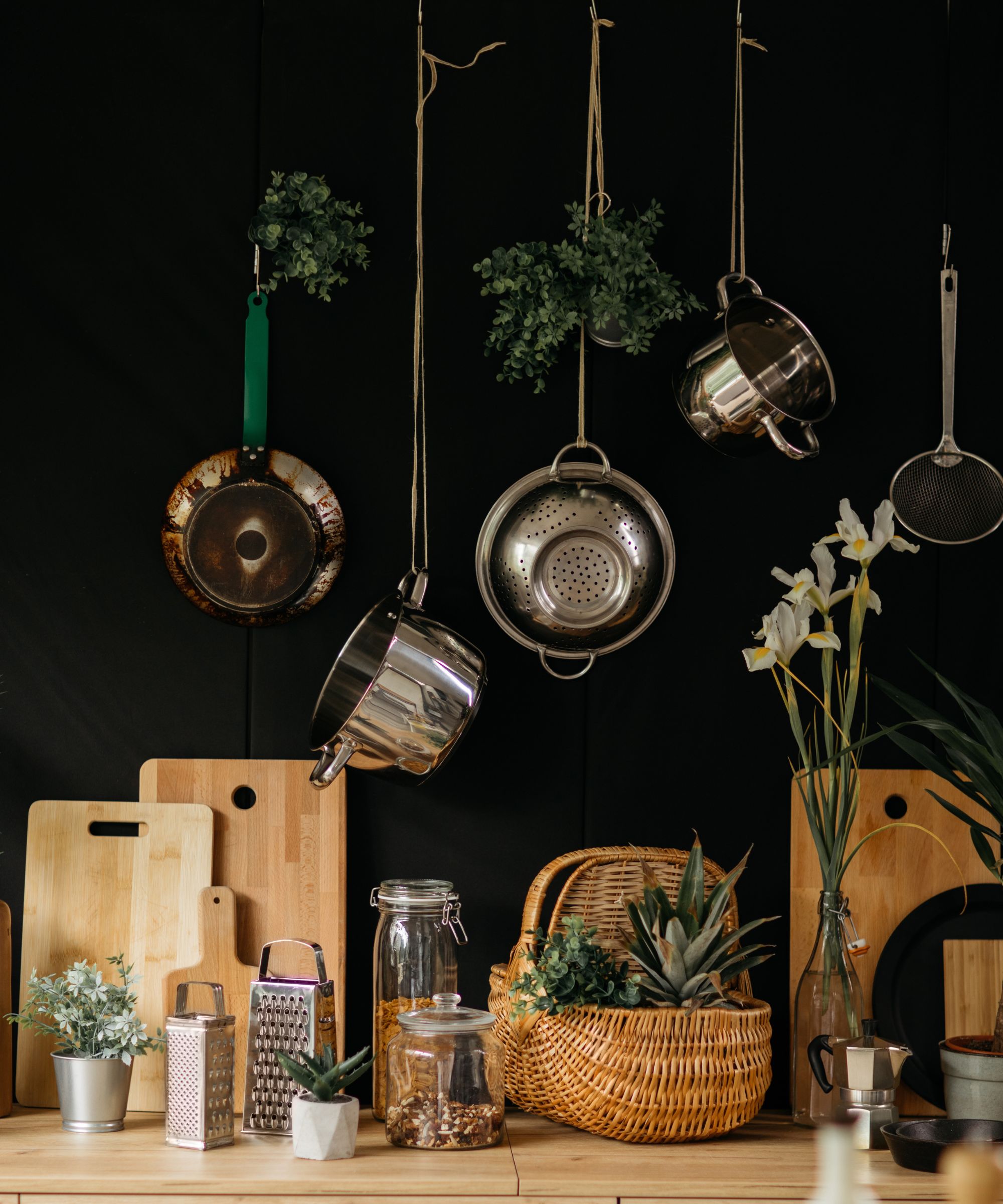
When space is at a premium, looking up can reveal a wealth of untapped storage opportunities. High ceilings aren’t just a coveted architectural feature, they’re also chance to add extra storage without eating into your kitchen’s footprint.
“If the ceilings are high then use this space too, and create high storage with tall wall cupboards, they may be harder to reach but the space can be invaluable,” says Helen Parker. "In a traditional or cottage style kitchen, you might also want to use your high ceilings for displaying decorative items such as baskets."
For a more practical approach, consider using overhead space for hanging storage. “If you prefer to keep utensils out of eye line, consider opting for a pot rack suspended over a peninsula or kitchen island,” suggests Nicolle Whyte. Not only does this free up drawer space, but it also ensures your most-used cookware is always close at hand.
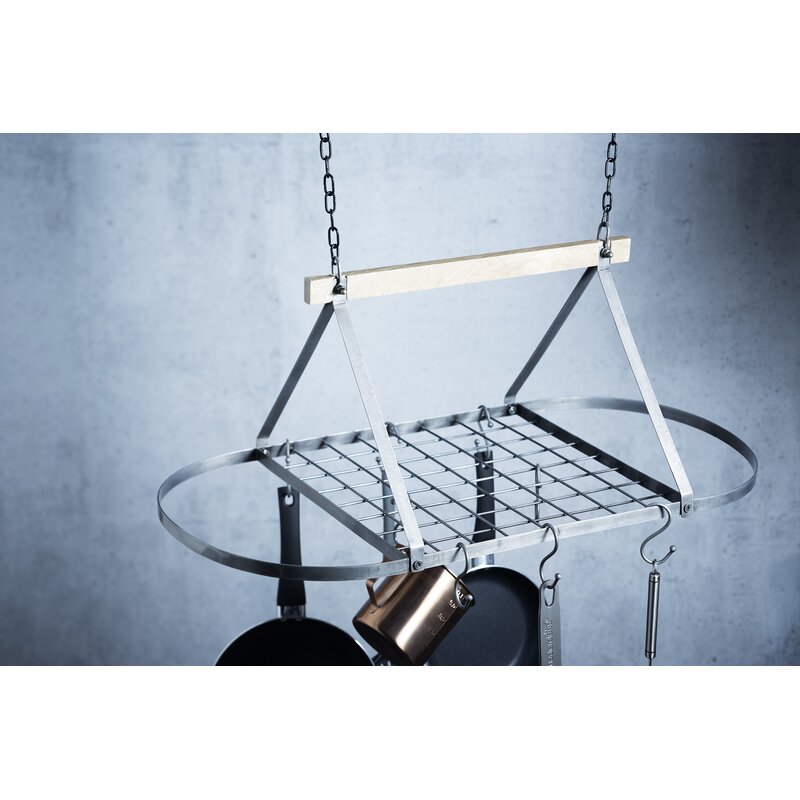
This ceiling-mounted pot rack is a practical and beautiful way to maximise limited kitchen storage space and create an eye-catching centrepiece above a small kitchen island.
5. Install a small kitchen pantry
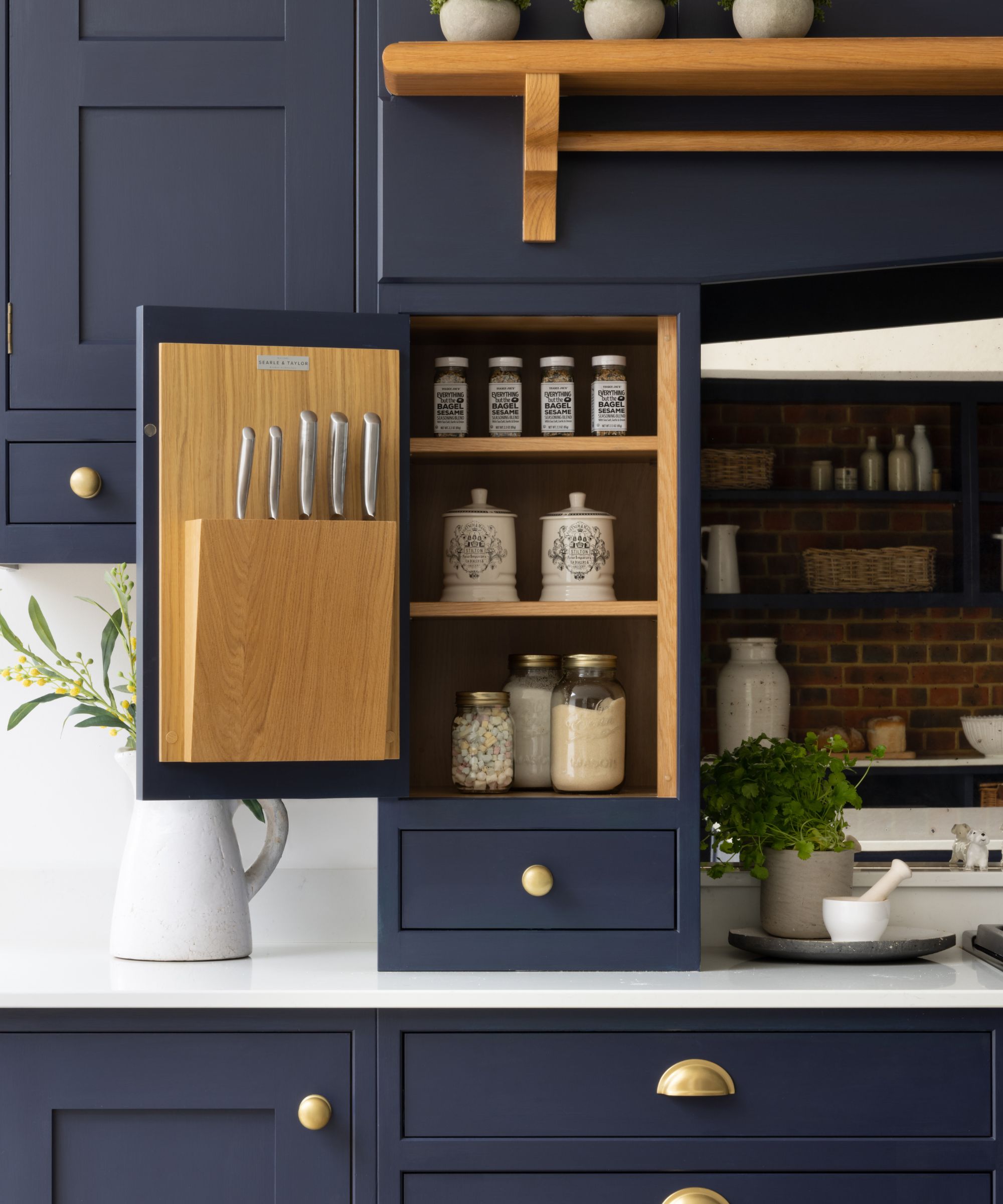
Don't let a compact space stop you from fulfilling your dream of having a pantry or larder – it's perfectly possible to have a pantry in a small kitchen. Richard Davonport, managing director at Davonport Kitchens, explains: “A pantry can be an excellent addition to a small kitchen as it helps you to organise your cupboards and should allow you to access everyday items much quicker.
"A designer will often apply the same principals as a large pantry cupboard but on a smaller scale. For example, making use of the inside of the pantry door for a spice or condiment rack, while also splitting the cupboard in half with a drawer section on the lower, and shelves in the top half of the cupboard. This provides much needed but organised storage, and that really is the trick when making a pantry work, whatever the space."

Richard Davonport is a luxury cabinetmaker and designer, and the founder and Managing Director of kitchen specialists, Davonport. The company designs and makes bespoke kitchens from its workshop in the heart of East Anglia.
6. Rework your kitchen drawers for optimal organisation
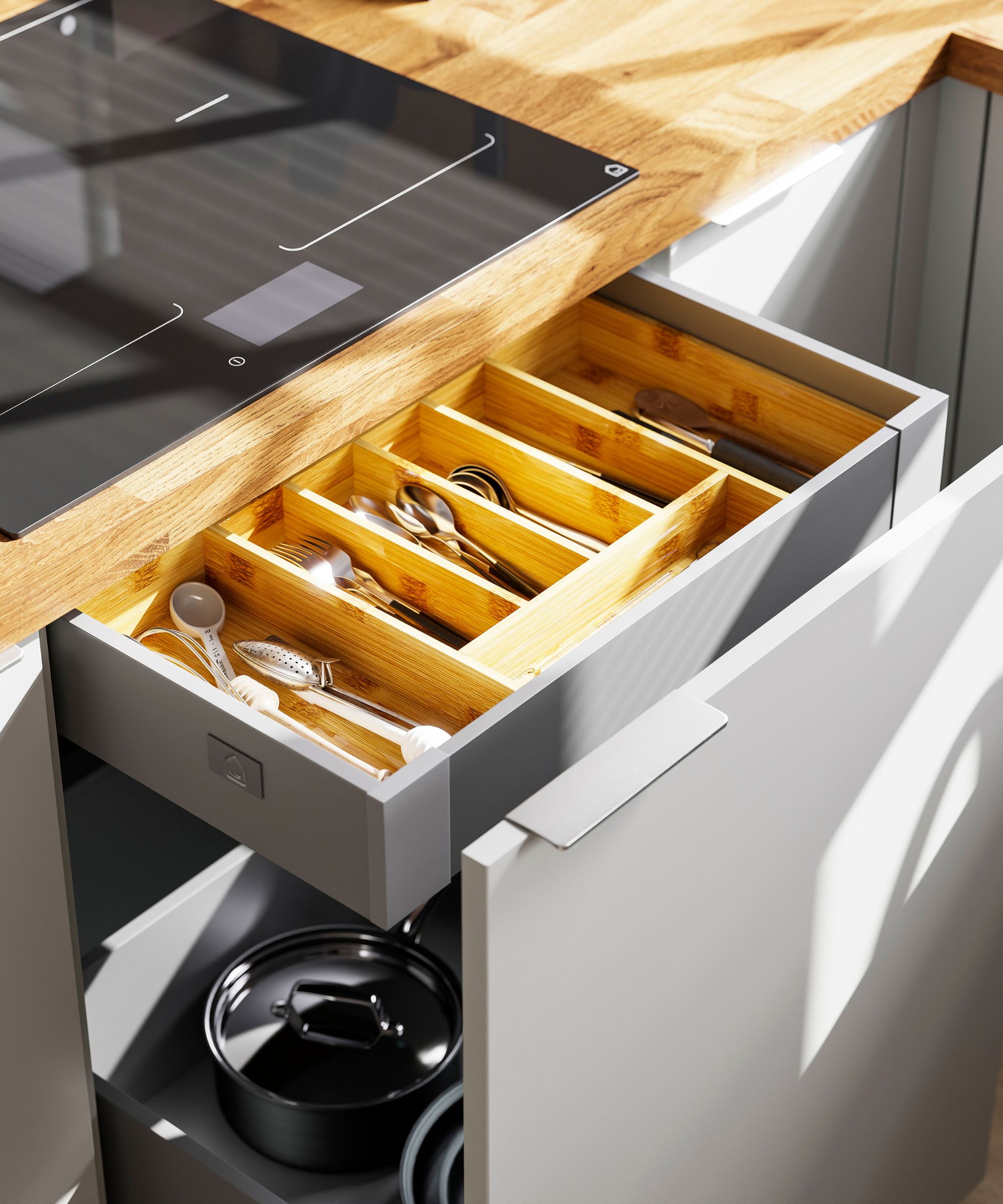
If your kitchen drawers are a jumble of utensils, measuring spoons, and forgotten gadgets, it’s probably time for a rethink. Well-organised drawers can make a small kitchen feel much more functional, helping you store more items without the headache of clutter.
"Organisation is key, and this flows from the internal layout of drawers, which can be thought through to house cutlery, spices, etc., to ensure everything has a home," says Jayne Everett from Naked Kitchens. Opt for deep drawers with built-in dividers to neatly separate cutlery, utensils, and other cooking tools. Layered or hidden inner drawers, like the ones pictured here from GoodHome at B&Q, create extra storage without taking up more space.
If you’re short on room for pots and pans, you may also want to consider wide, soft-close drawers with adjustable inserts to keep everything tidy.
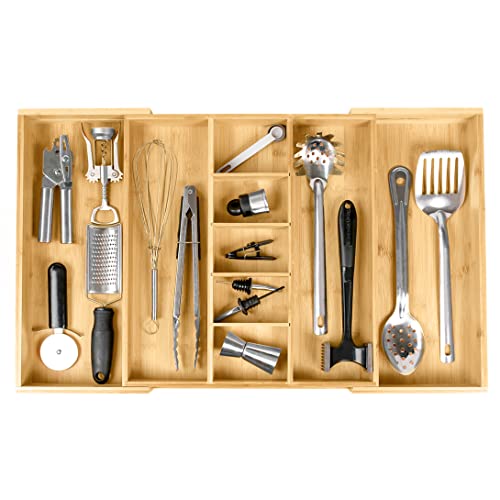
This expandable drawer organiser is made from natural bamboo and allows you to create your own custom configuration for organising your kitchen utensils.
7. Use rails and hooks to achieve a rustic kitchen aesthetic
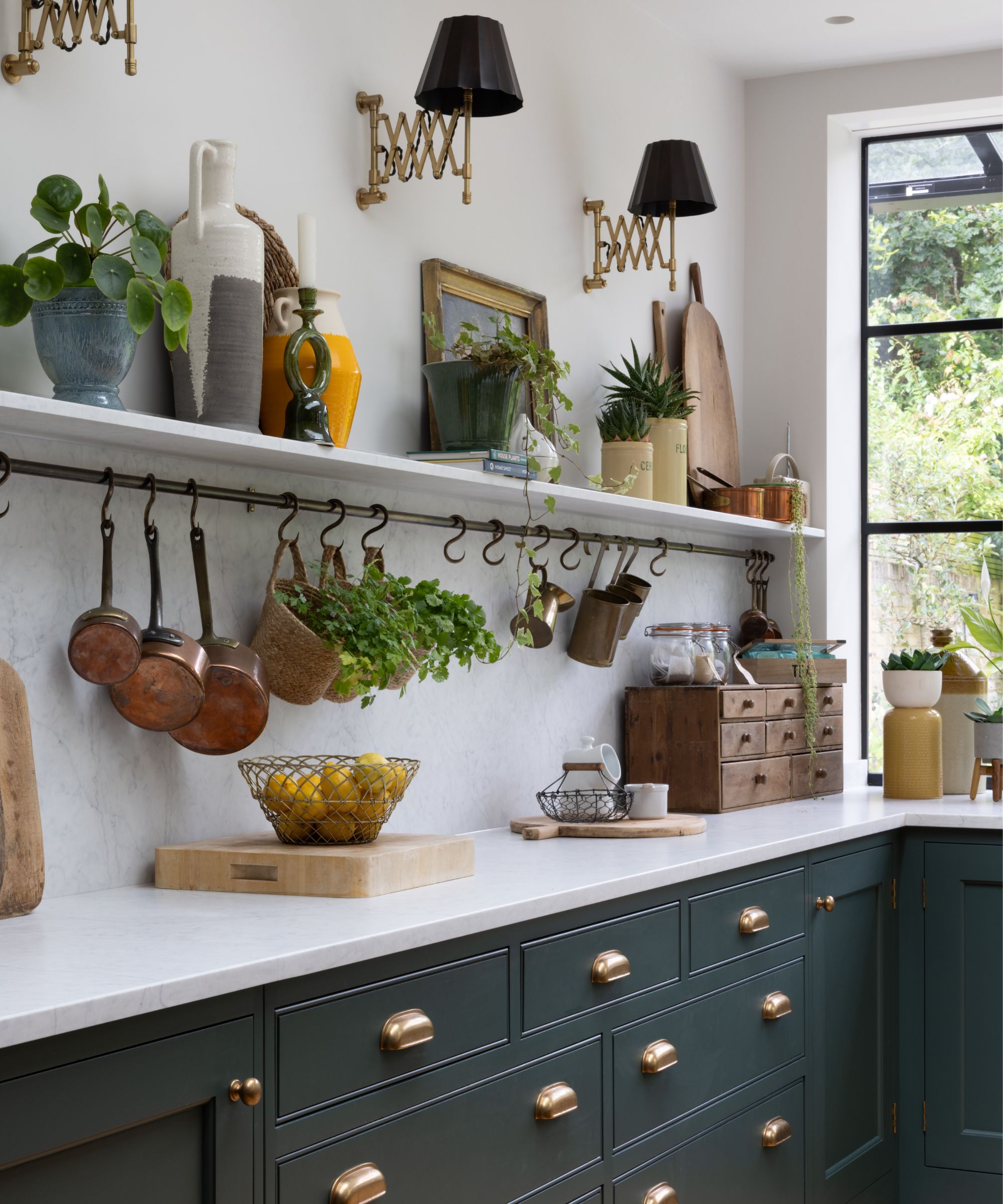
“If you're happy to display your cookware, hooks and rails are a creative and charming solution, especially when grappling with limited storage space," says Nicolle Whyte from Olive & Barr. "The versatility of hooks allows you to hang them anywhere in your kitchen, transforming everyday items into visually appealing features."
Use sturdy hooks to keep pots, pans, and utensils neatly stored, or install a rail with S-hooks for mugs and dish towels. “These accessories are super practical and can also be used to hang greenery, such as spices, which look great,” says Jayne Everett.
A rail with a sleek chrome finish is perfect for a modern kitchens, while warm wood or an antique brass rail would complement a more traditional farmhouse kitchen. However you choose to style them, hooks and rails offer a simple, space-saving solution that turns your kitchen essentials into part of the décor itself.
Shop For Kitchen Rails & Hooks
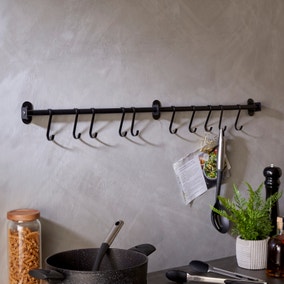
Whether you're hanging oven gloves, tea towels and even serving spoons, these hooks are a great space saving solution.
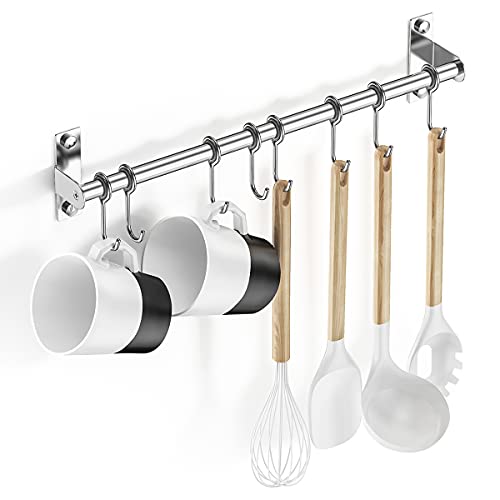
This affordable rack is made of 304 stainless steel and all the hooks are 360-degree rotatable.
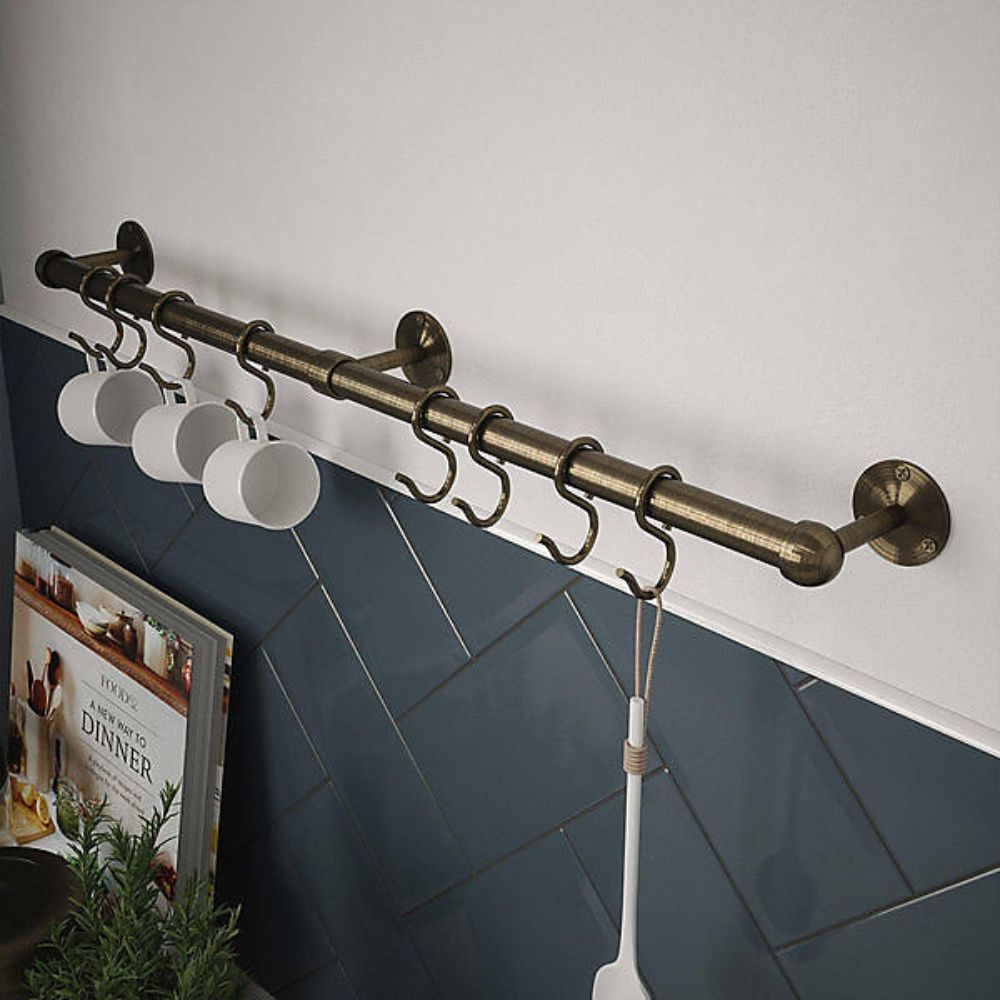
These utensil rail kits are available in 4 trending colour finishes to match your chosen kitchen décor.
8. Consider a carving out a small kitchen niche
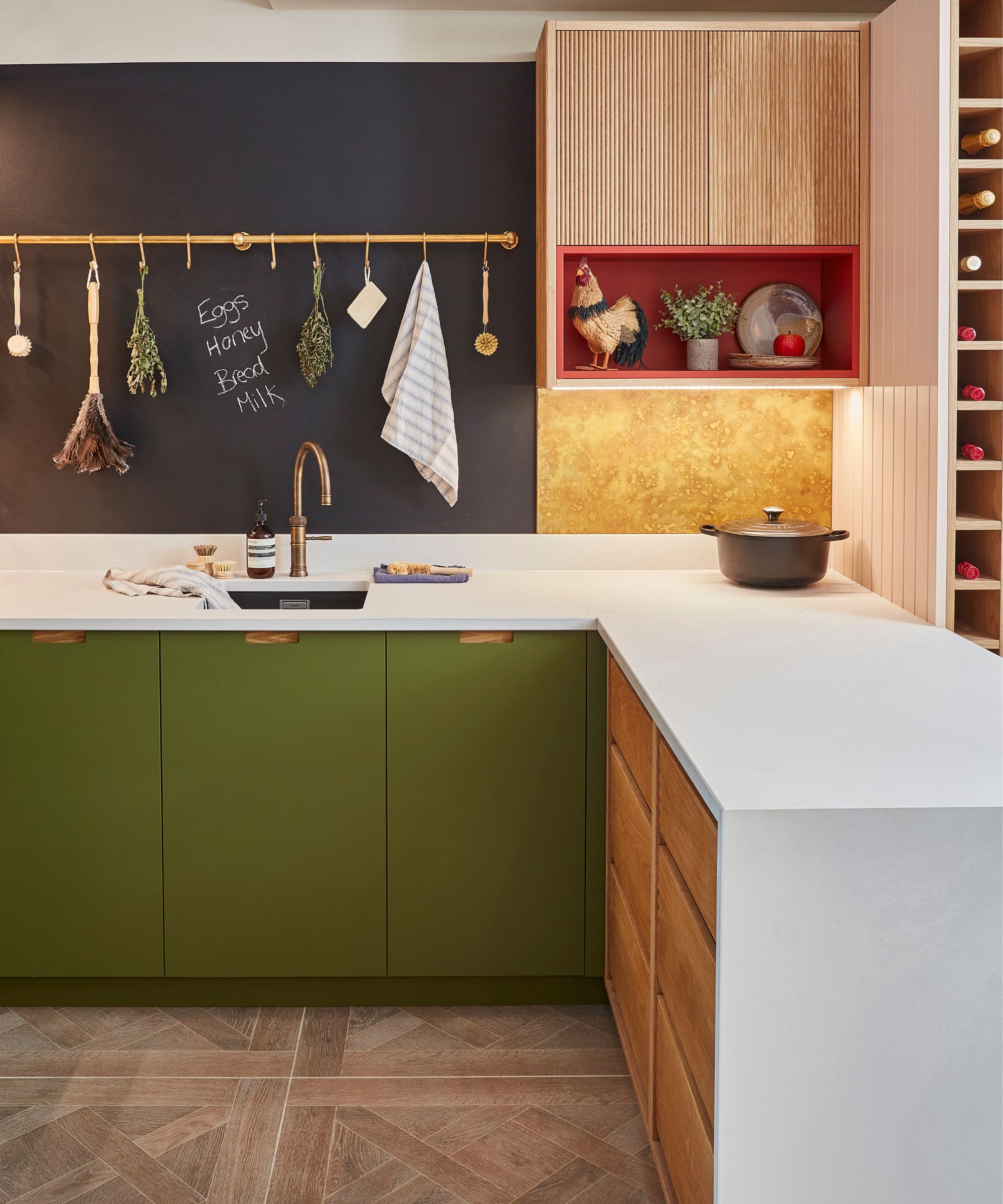
In a tiny kitchen, even the most unexpected spaces can become useful storage. Instead of leaving awkward recesses or empty walls unused, consider turning them into a sleek, built-in niche.
“A small indent in a wall is a perfect place to fit some slim shelves and when painted the same colour as the walls, almost disappear,” says Helen Parker. This subtle trick blends storage seamlessly into the space, making it feel intentional rather than added on.
If you're in the process of renovating a kitchen, factoring in a niche from the start allows for a more seamless look. But even in an existing kitchen, a simple recessed shelf can be retrofitted into a stud wall or an underutilised alcove, offering practical storage for cookbooks, spice jars, or decorative touches, without encroaching on valuable space.
9. Add handy storage to the back of your doors
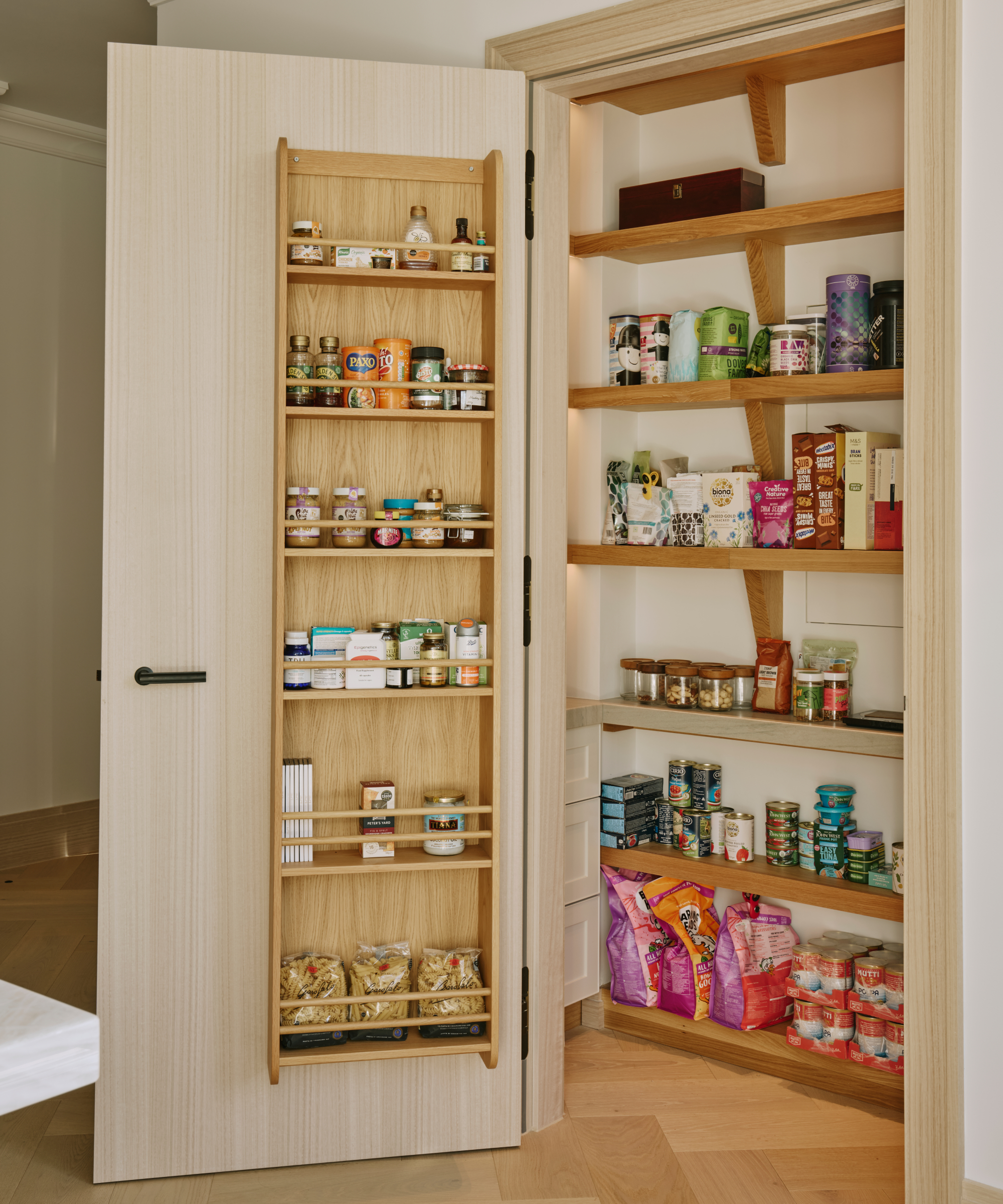
When space is tight, don’t forget that the back of a door can offer a valuable extra storage. Whether it’s a pantry door, a cabinet door, or even the kitchen entrance, adding hooks, rails, or slim shelving can help keep everyday essentials organised and out of the way.
Over-the-door racks are perfect for storing spices, chopping boards, or cleaning supplies, and are relatively inexpensive.
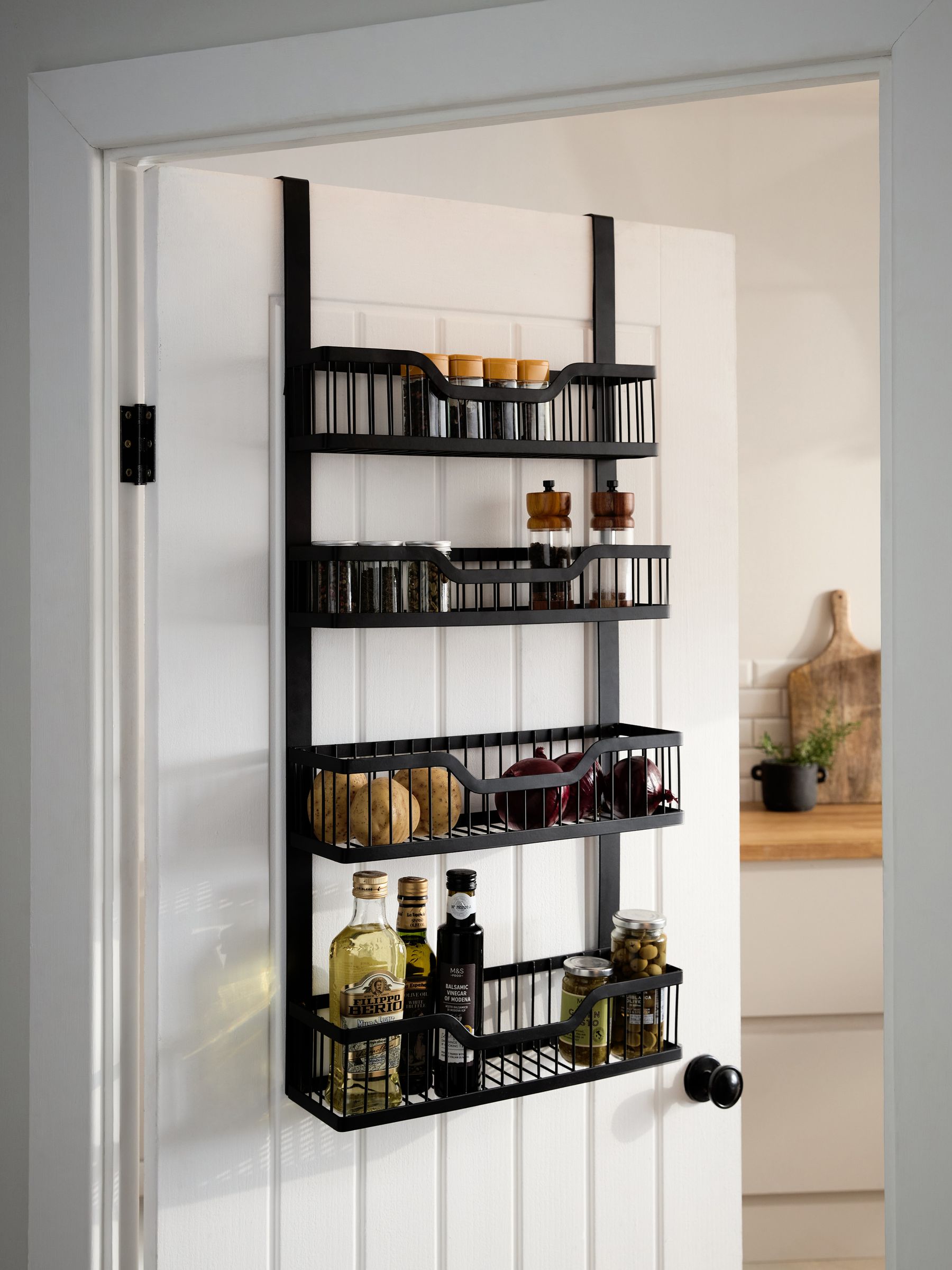
Tight on space? No problem. This over-the-door kitchen storage unit is perfect for keeping your kitchen organised and clutter-free.
10. Purchase a slimline trolley or mobile bar for moveable storage
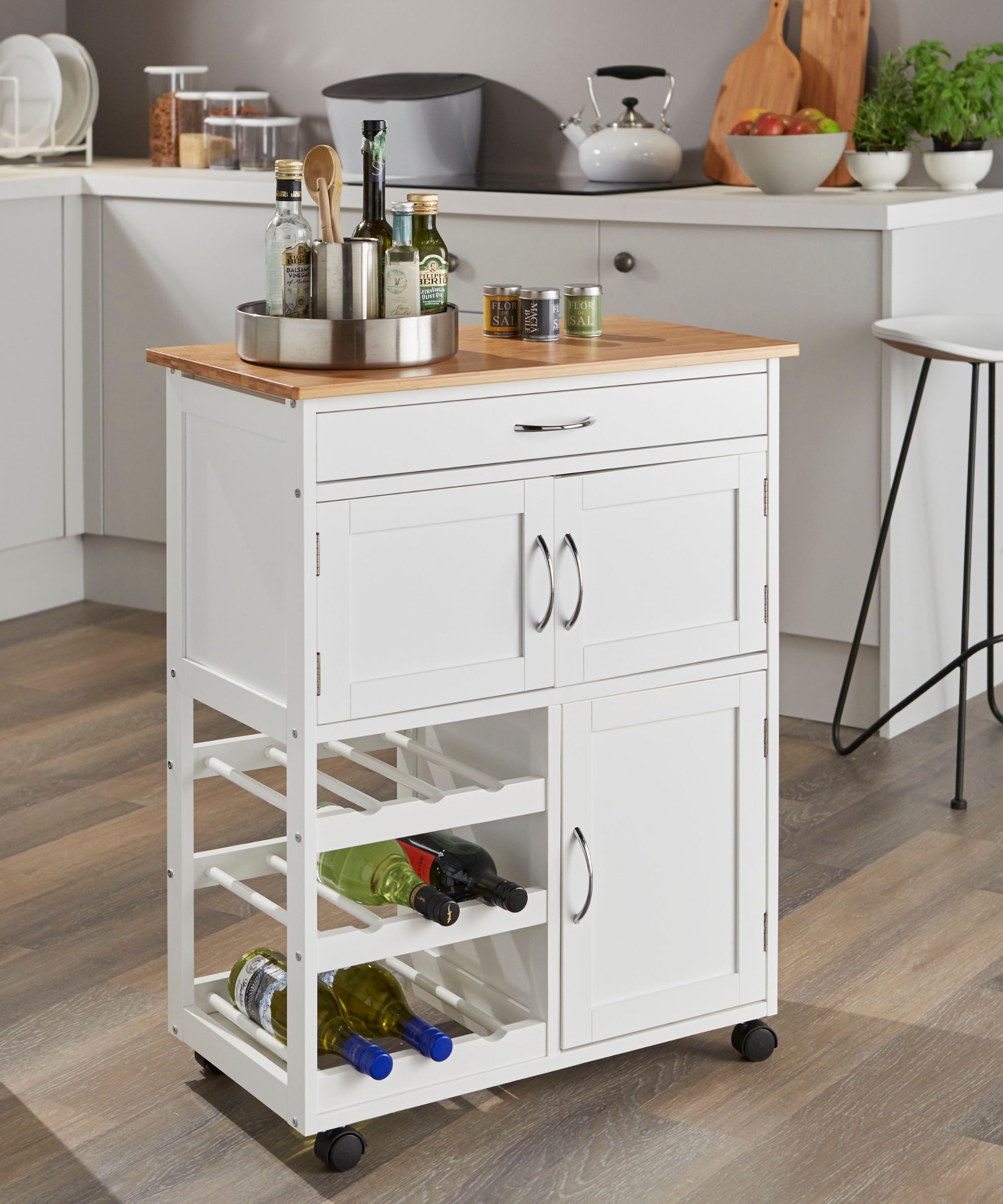
When you’re in need of extra space but don’t have any more room for built-in storage, a slimline trolley or mobile bar can make all the difference. These compact, moveable pieces are designed to fit neatly into tight spaces, whether tucked beside a cabinet, against a wall, or even slid into a narrow gap between kitchen appliances. You can use a trolley to store everyday essentials like cooking oils, spices, or utensils, or style it as a chic mobile bar for entertaining guests.
Top Tip: It's a good idea to opt for a design with wheels so it can be easily moved when needed.
11. Think outside the box with with pull-out drawers and cupboards
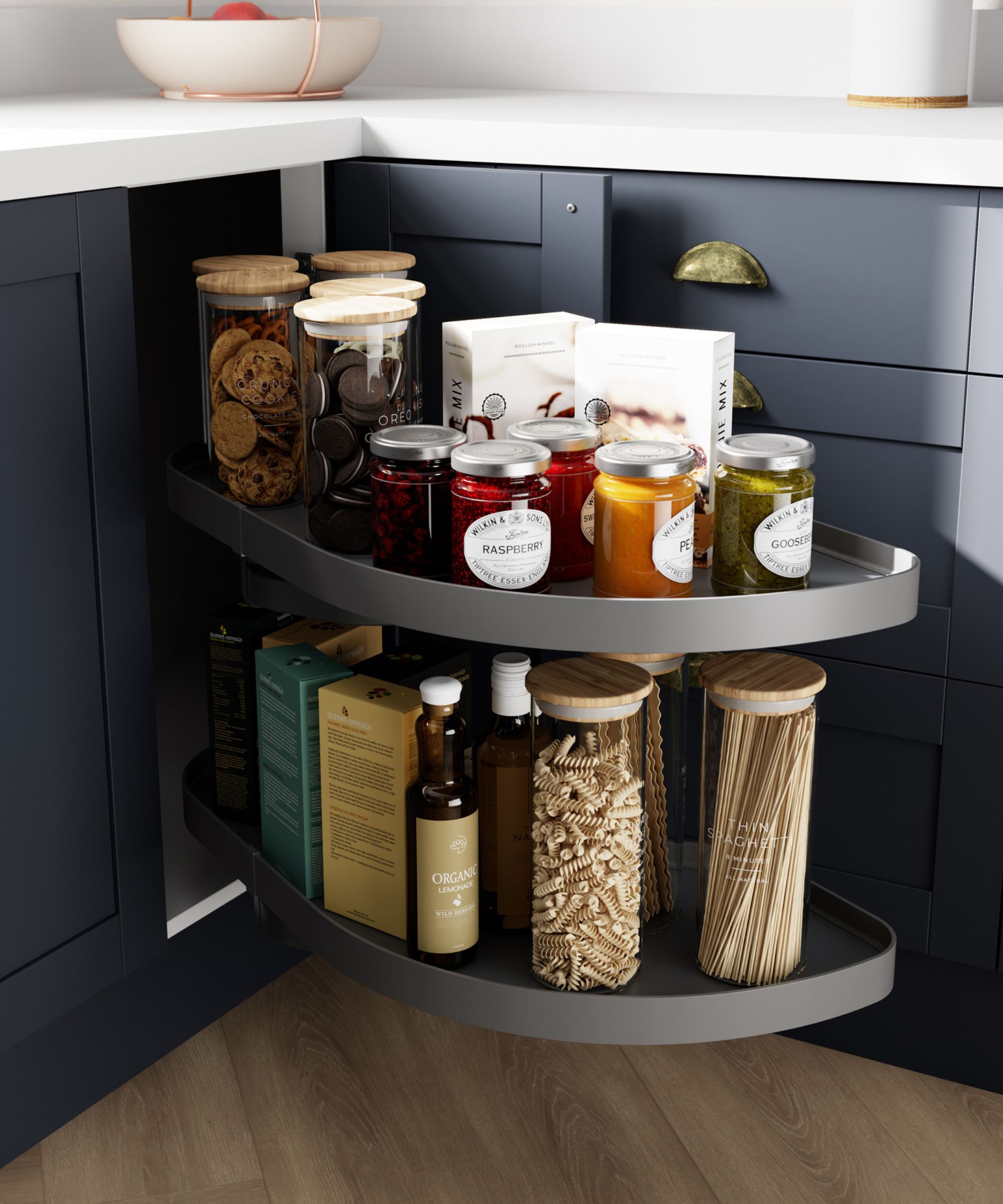
It can be tricky to make a traditional cupboard work in a small kitchen, as they often leave hard-to-reach corners or wasted space at the back of shelves. That’s where pull-out drawers and carousel storage comes in. Deep pull-out drawers are ideal for keeping pots, pans, and dry goods neatly organised, while slim pull-outs can make use of narrow gaps for storing baking trays.
"It’s essential to make use of every corner with an efficient pull-out, allowing you to store items like pots and pans with ease," says Jayne Everett. Corner carousels and pull-out drawers ensure every part of a cupboard is easy to access, helping you get the most out of your kitchen without rummaging through old containers and clutter.
Shop pull-out kitchen organisers
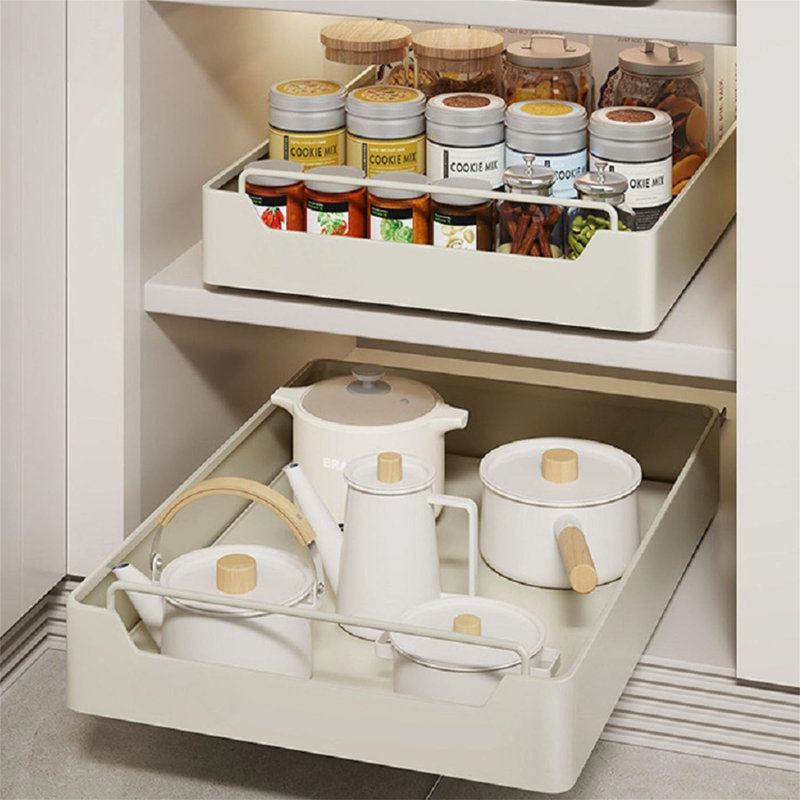
These handy pull-out dividers require no drilling or nailing and are perfect for storing and organising loose items.
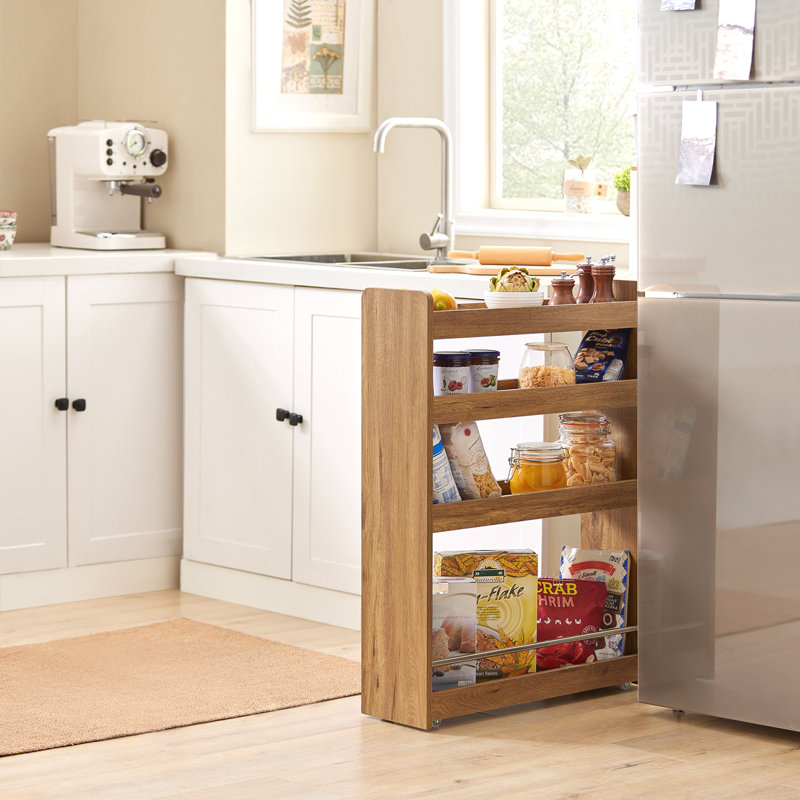
This portable shelving rack allows you to create space in niches or gaps of up to 18cm in your kitchen.
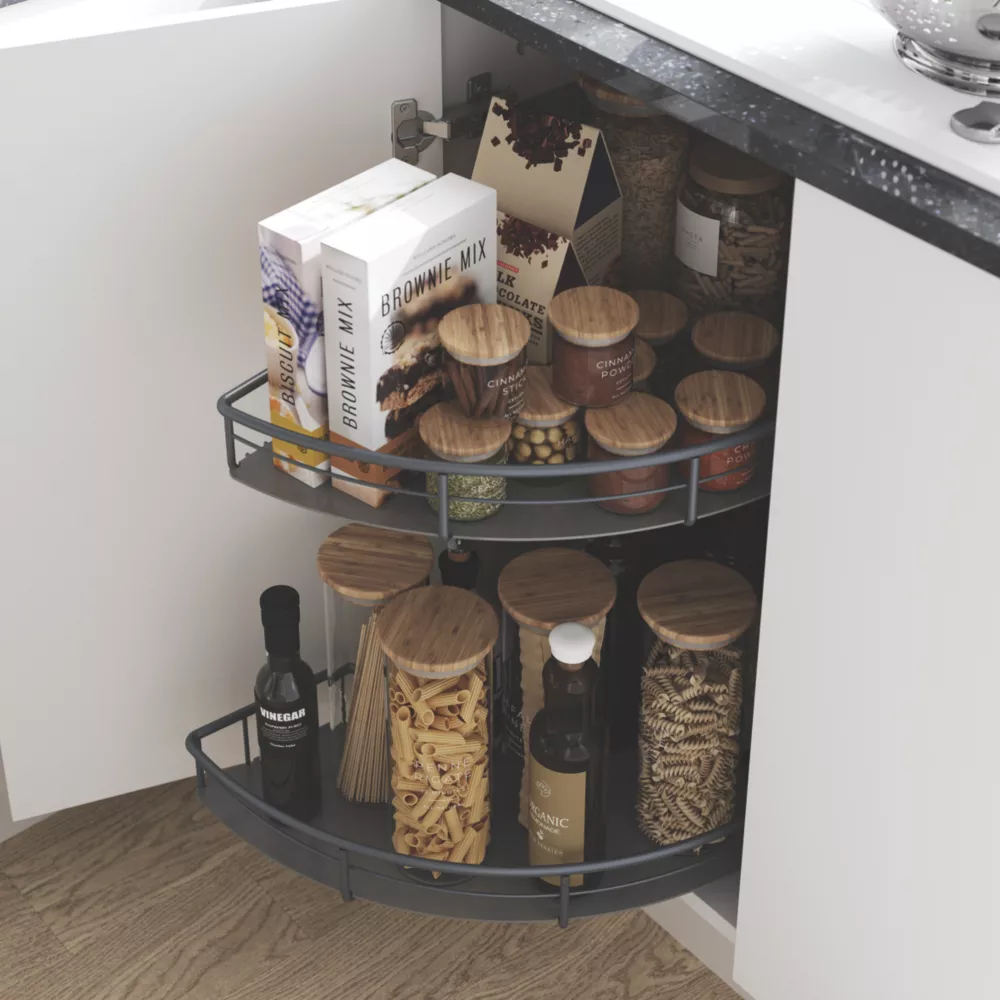 Perfect for corners
Perfect for corners
This easy-to-install carousel storage system fits inside deep kitchen cabinets to let you use every inch of space.
12. Turn unused corners into helpful storage spots
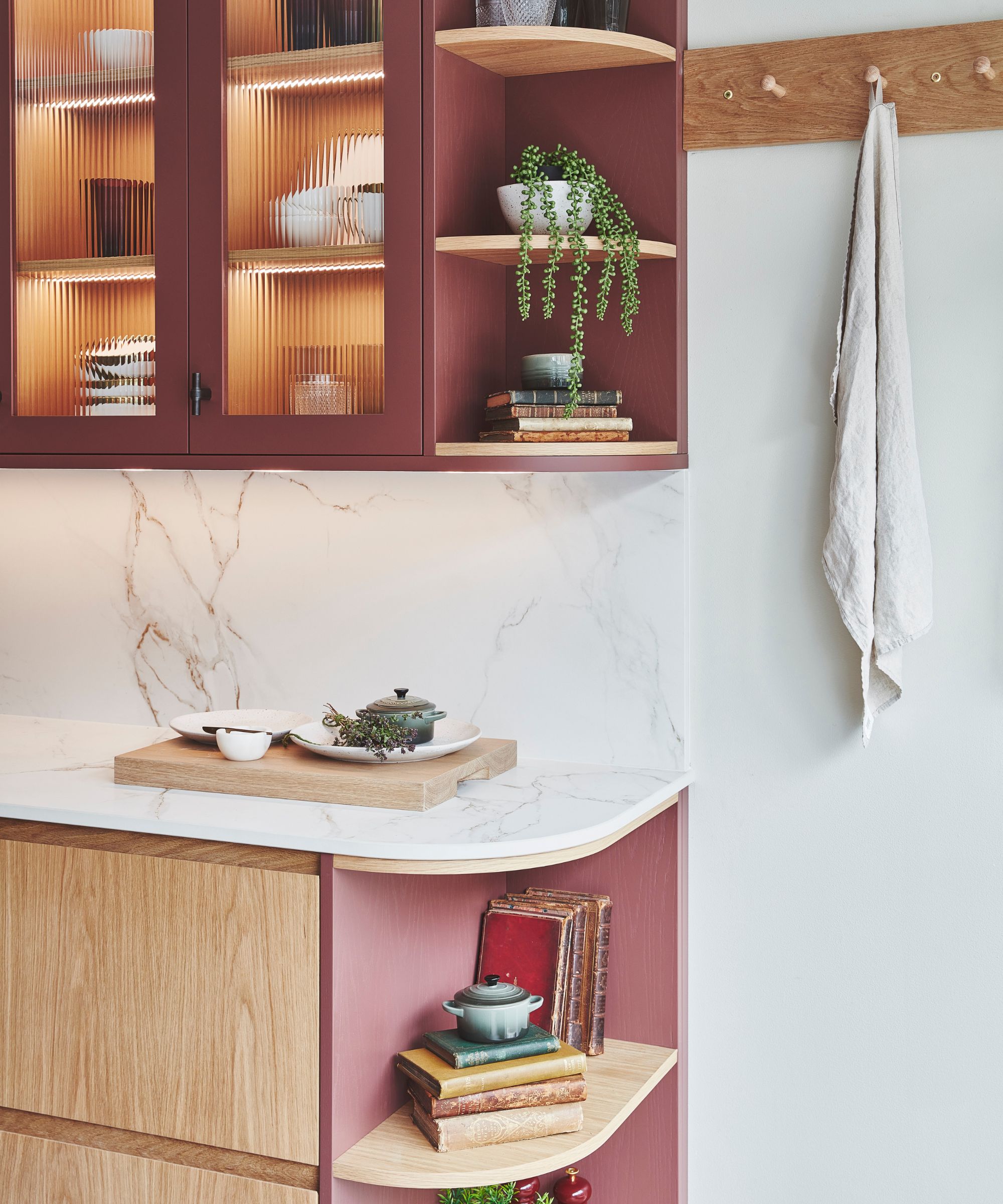
Corners can be some of the most underutilised spaces in a kitchen, but with the right storage solutions, they can actually be incredibly functional. Instead of letting them go to waste, consider installing corner shelving or, if space allows, built-in corner banquette seating with hidden storage.
As seen in this beautiful design by Naked Kitchens, curved corner shelves offer a clever and stylish way to make use of awkward spaces. Open corner shelving softens the look of cabinetry while providing a handy spot for cookbooks, decorative pieces, or everyday kitchen essentials.
FAQs
How can you make a small kitchen look less cluttered?
“Keep colours to a minimum and try to stick to a calm and soft kitchen colour palette to avoid things feeling busy,” recommends Helen Parker, creative director of deVOL. “It's surprising how a limited selection of colours creates a more serene and tidy feel to a room. Finally, just get rid of bulky items and things that you don’t use, as storage is tight you should make sure everything you keep is used and useful.”
What is the best way to add storage to a narrow kitchen?
“Staggering the depth of your worktops is a good option for narrow kitchens, as it allows you to create small shallow areas for seating or slimline storage cupboards,” explains Helen Parker. “If your kitchen is long and thin, a staggered worktop is the perfect solution for a little breakfast bar, as galley kitchens rarely have enough width for a kitchen table.”
Planning a kitchen remodel? Smart storage solutions can help you squeeze in more space, stay organised, and make your kitchen work harder for you.
Get the Homebuilding & Renovating Newsletter
Bring your dream home to life with expert advice, how to guides and design inspiration. Sign up for our newsletter and get two free tickets to a Homebuilding & Renovating Show near you.

Gabriella is an interiors journalist and has a wealth of experience creating interiors and renovation content. She was Homebuilding & Renovating's former Assistant Editor as well as the former Head of Solved at sister brand Homes & Gardens, where she wrote and edited content addressing key renovation, DIY and interior questions.
She’s spent the past decade crafting copy for interiors publications, award-winning architects, and leading UK homeware brands. She also served as the Content Manager for the ethical homeware brand Nkuku.
Gabriella is a DIY enthusiast and a lover of all things interior design. She has a particular passion for historic buildings and listed properties, and she is currently in the process of renovating a Grade II-listed Victorian coach house in the West Country.
